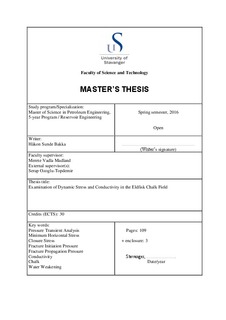| dc.contributor.author | Bakka, Håkon Sunde | |
| dc.date.accessioned | 2016-09-20T13:52:27Z | |
| dc.date.available | 2016-09-20T13:52:27Z | |
| dc.date.issued | 2016-05-26 | |
| dc.identifier.uri | http://hdl.handle.net/11250/2408861 | |
| dc.description | Master's thesis in Petroleum engineering | nb_NO |
| dc.description.abstract | This thesis work has been conducted in cooperation with ConocoPhillips Norway and looks at the stress development in the Eldfisk chalk reservoir. High injection pressures due to the relatively low permeabilities of chalk reservoirs are known to form tensile fractures (Rod and Jørgensen 2005). Tensile fractures may lead to bypassing of hydrocarbons and early water breakthrough in producers. Knowing when and if tensile fractures will form is therefore important to ensure maximum recovery.
Analysis of 32 minifrac falloff tests have shown that the Eldfisk minimum principal stress (𝜎������ℎ) conforms to a linear trend as a function of the pore pressure gradient. A linear regression model has been proposed for the closure gradient, with a slope of 0.72 and intercept of 0.31 psi/ft. A linear trend is seen for the closure stress data despite significant pore collapse and inelastic deformation, suggesting that plastically deformed chalk continues to behave partially elastic.
Analysis of 10 minifrac Step Rate Tests have shown that the additional pressure required to initiate a fracture is on average 600 psi above the closure stress. The difference is independent of pore pressure, and indicates relatively uniform redistribution of stress around the horizontal wellbores.
Pressure Transient Analysis of minifrac Step Rate Tests have shown that valuable information on fracture mechanics can be extracted from short test durations. The results indicate that completed zone lengths will influence the fracture development, and suggests that varying fracture half-length may be a consequence in wells with large variation in perforation zone lengths.
Time-lapse Pressure Transient Analysis of two injection wells on the Eldfisk Field (B-22 and B-8 B) has indicated no tensile fracture growth despite high injection rates and pressures. However, up to ~4-times increase in reservoir conductivity was seen in the area around B-8 B, while no significant change was seen around B-22. A conceptual model has been proposed that uses the minimum principal stress to explain the difference in B-8 B and B-22 behavior. The increase in conductivity around B-8 may be a result of natural fracture network expansion when the injection pressures exceed the closure stress. B-22 sees no change as injection pressures are below the local closure stress. Stress arching is believed to be important as it reduced the closure stress on the crest and increases the closure stress on the flanks.
Chemical alterations induced as part of a water weakening mechanism are proposed to influence the conductivity development in areas around injectors. Core experiments indicate that seawater flowing through the natural fracture networks could lead to significant chemical alterations in and around the fractures (Madland et al. 2015). These alterations may lead to partial filling of the fractures, influencing the fracture permeability and reducing the stress dependency of the fracture network conductivity. | nb_NO |
| dc.language.iso | eng | nb_NO |
| dc.publisher | University of Stavanger, Norway | nb_NO |
| dc.relation.ispartofseries | Masteroppgave/UIS-TN-IPT/2016; | |
| dc.rights | Navngivelse 3.0 Norge | * |
| dc.rights.uri | http://creativecommons.org/licenses/by/3.0/no/ | * |
| dc.subject | petroleumsteknologi | nb_NO |
| dc.subject | reservoarteknologi | nb_NO |
| dc.subject | petroleum engineering | nb_NO |
| dc.subject | reservoir technology | nb_NO |
| dc.subject | minimum horizontal stress | nb_NO |
| dc.title | Examination of Dynamic Stress and Conductivity in the Eldfisk Chalk Field | nb_NO |
| dc.type | Master thesis | nb_NO |
| dc.subject.nsi | VDP::Technology: 500::Rock and petroleum disciplines: 510::Petroleum engineering: 512 | nb_NO |

